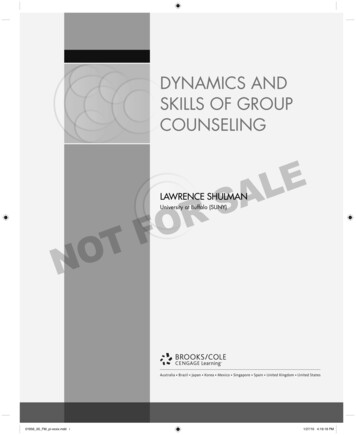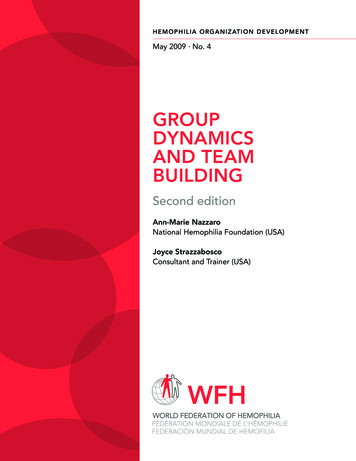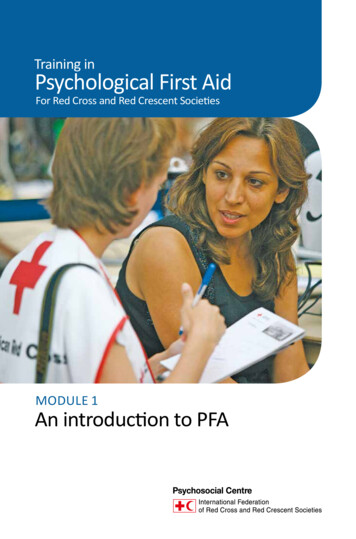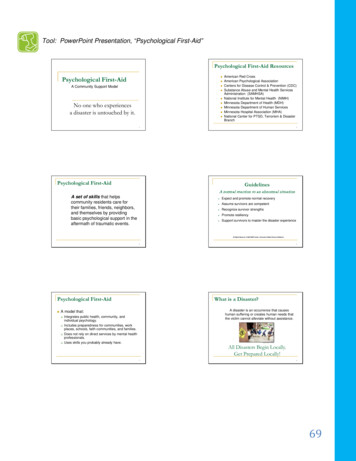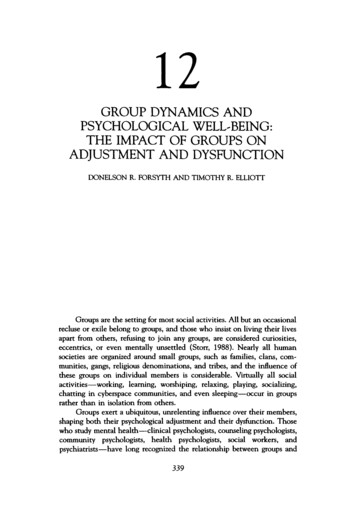
Transcription
12GROUP DYNAMICS ANDPSYCHOLOGICAL WELL-BEING:THE IMPACT OF GROUPS ONADJUSTMENT AND DYSFUNCTIONDONELSON R. FORSYTH AND TIMOTHY R. ELLIOl'TGroups are the setting for most social activities. All but an occasionalrecluse or exile belong to groups, and those who insist on living their livesapart from others, refusing to join any groups, are considered curiosities,eccentrics, or even mentally unsettled (Storr, 1988). Nearly all humansocieties are organized around small groups, such as families, clans, communities, gangs, religious denominations, and tribes, and the influence ofthese groups on individual members is considerable. Virtually all socialactivities-working,learning, worshiping, relaxing, playing, socializing,chatting in cyberspace communities, and even sleeping-occur in groupsrather than in isolation from others.Groups exert a ubiquitous, unrelenting influence over their members,shaping both their psychological adjustment and their dysfunction. Thosewho study mental health-clinical psychologists, counseling psychologists,community psychologists, health psychologists, social workers, andpsychiatrists-have long recognized the relationship between groups and339
members’ psychological well-being. Pratt (1922), as early as 1905, foundthat patients suffering from tuberculosis improved when they took part insmall-group discussions and listened to inspirational lectures. When Moreno (1932) used sociometric methods to create cohesive subgroups in aninstitutionalized population, he documented increases in adjustment anddecreases in interpersonal conflict. Freud (1922), in an insightful rebuttalto the idea that people in groups become a mob or lose their individualidentities, argued that groups are essential to most adults’ mental health.Lewin (1936) founded the scientific field of group dynamics, and his training groups, “T-groups,” provided the template for a wide variety of interpersonal, group-based training techniques.In this chapter we seek, in a limited way, to reestablish the linkbetween the social psychology of groups and the application of group dynamics to understand clinical and interpersonal dysfunction. We begin ouranalysis by asking some fundamental questions: Are groups real, in a psychological sense? Are individuals who are members of groups influenced,in fundamental ways, by these memberships?Can their adjustment, health,and dysfunction be understood if these memberships are ignored? If groupsare not real, then little can be gained from examining their influence onthe psychological adjustment of individuals.THE REALITY OF GROUPSGroups lie at the center of one of the great debates in the field ofpsychology and sociology: Are groups real? Durkheim (1897/1966), for example, argued that his analysis of suicide provided clear evidence of thereality of groups because it explained psychological despair in purely grouplevel terms. Durkheim also endorsed the conclusions of Le Bon (1895/1960) and other crowd psychologists, going so far as to conclude that people in large groups can become so deindividuated that they act with asingle, and somewhat delusional, mind. Durkheim believed that the collective conscious can be so powerful that it blots out the group members’will.Although McDougall (1908) agreed with many of Durkheim’s (1897/1966) conclusions-and traced much of the influence of groups over individuals back to humanity’s instinctive gregariousness-most psychologists questioned the significance of groups and group-level processes.Allport (1924) argued forcefully against the scientific legitimacy of groupconcepts when he concluded that “the actions of all are nothing morethan the sum of the actions of each taken separately” (p. 5). Groups,according to Allport, were not real entities, and he felt that the behaviorof individuals in groups could be understood by studying the psychology ofthe group members.340FORSYTH AND ELLIOTT
Few contemporary psychologists would agree with Allport’s ( 1924)radical rejection of the importance of studying groups, but vestiges of thisantigroup orientation continue to influence theorists’ and researchers’ willingness to consider group-level concepts when explaining maladaptive andadaptive processes. Asked why an individual is depressed, addicted, or engages in aberrant actions, many psychologists would focus on internal, psychological determinants of behavior. Extant clinical conceptualizationsandintervention models adopt this so-called “psychogenic perspective” whenthey emphasize personality traits, genetic factors, past events, and biological processes as causes of dysfunction (Forsyth &I Leary, 1991). This biashas been summarized unabashedly by Urban (1983)’ who argued that whenpsychologists look for causes outside of the individual, they “deny anddistort the essential quality of human existence. Everything of significancewith regard to this entire process occurs within the inner or subjectiveexperience of the individual” (p. 163). Psychogenic approaches assume thatpsychological states mediate the relationship between the external worldand the person’s reaction to it.This psychogenic perspective slights the very real impact of groupson individual members. Even Allport (1962) admitted that people sometimes act differently when they are in groups. Some of these changes aresubtle. Moving from isolation to a group context can reduce people’s senseof uniqueness while also enhancing their ability to perform simple tasksrapidly (Triplett, 1898). Interacting with other people can also promptindividuals to gradually change their attitudes and values as they come toagree with the overall consensus of the group (Newcomb, 1943). In groups,individuals acquire a sense of shared identity, social support, and most oftheir values. Groups also can change people more dramatically. Milgram’s(1963) studies of obedience, for example, placed participants in threeperson groups. The experimenter, who has much of the authority in thesetting, told the participant to deliver painful electric shocks to anotherperson. The shocks were bogus, but the harm seemed real to the participants. Nonetheless, fewer than 35% of the participants were able to resistthe demands of their role by refusing to follow orders. More recently, Inskoand his colleagues have verified the discontinuity effect: People are muchmore competitive when they are in groups responding to other groupsrather than individuals responding to other individuals (Pemberton, Insko,& Schopler, 1996). Groups may just be collections of individuals, but thiscollective experience changes the members.Groups also possess characteristics that go beyond the characteristicspossessed by individual members of the group. A group’s cohesiveness, forexample, is more than the mere attraction of each individual member forone another (Hogg, 1992). Individuals may not like each other on a personal level, yet when they form a group they experience powerful feelingsof unity and espnt de corps. Groups seem to possess supervening qualitiesGROUP DYNAMICS34 1
“that cannot be reduced to or described as qualities of its participants’’(Sandelands & St. Clair, 1993, p. 443). Group membership can transcendplace and collapse space, so that the sense of community and belongingnessconnects each participating member with unseen others who share andsubscribe to the salient features of the group. As Lewin’s (1951) gestaltorientation argues, a group is greater than the sum of its parts.Individuals also readily hypostatize groups: They perceive them to bereal and assume that their properties are influential ones. Not all collections of individuals are groups, but the perceiver considers an aggregatewith certain qualities to be a group. Campbell’s (1958) analysis of entitativity (perceived groupness), for example, argues that perceptual factors suchas common fate, proximity, and similarity influence both members’ andnonmembers’ perceptions of a group’s unity. Other investigators haveshown that observers, once they decide that they are observing a grouprather than a collection of individuals, no longer monitor which personsaid what, only which group said what (Brewer, Weber, & Carini, 1995,Experiment 1). Groups are as real as individuals, at least at a perceptuallevel (Hilton & von Hippel, 1990; McConnell, Sherman, & Hamilton,1994a, 199413).In summary, a group-dynamics approach to psychological well-beingand dysfunction rejects the idea that analyses that focus on individual-levelmechanisms are superior to ones that emphasize group-level mechanisms.Groups possess features that go well beyond the characteristicsof individualmembers, and observers’ impressions of people differ when they think thepeople they are watching are members of a unified group. Groups alsoinfluence their members in both subtle and dramatic ways, and some ofthese influences affect their mental health. We review some of these relationships between groups and psychological adjustment, but our reviewis a selective one. We provide examples of the relationship between groupsand mental health rather than a comprehensive cataloging of all linkages.Also, whereas Levine and Moreland (1992) examined the impact of particular types of groups (e.g., families, work groups, school groups) on mentalhealth, we examine how group processes (e.g., social support, socialization)influence health. We also focus on nontherapeutic groups and refer interested readers to other treatments of the relationship between group dynamics and group psychotherapy (e.g., Forsyth, 1991).GROUPS, REJECTION, AND LONELINESSJames Pelosi made many friends when he first entered West Point, butall that changed when he was charged with an honor code violation.He was exonerated by a student court, but his fellow cadets believedhe was guilty. They sentenced him to The Silence: No student spoketo him or interacted with him in any way for nearly 2 years. He felt342FORSYTH AND ELLIO7T
lonely and depressed much of the time and lost 26 lb during the period.(adapted from Steinberg, 1975)Theory and research suggest that people need to be connected toother people and that they experience significant psychological distress ifthese connections are severed. Baumeister and Leary’s ( 1995) belongingness hypothesis, for example, argues that “human beings have a pervasivedrive to form and maintain at least a minimum quantity of lasting, positive,and impactful interpersonal relationships” (p. 497). They likened the needto belong to other basic needs, such as hunger or thirst. Just as an inadequate diet can undermine one’s health, separation can lead to pronouncedpsychological discomfort.Groups play an essential role in satisfying the need to belong. Yearsago, Freud (1922) argued that membership in groups promotes mentalhealth because groups take the place of childhood families when peoplereach adulthood. Freud developed the concept of trQnSference when he observed that some of his patients reacted to him as if they were childrenand he was their parent. He theorized that a similar transference occurs ingroups when individuals accept leaders as authority figures. This transference leads to identification with the leader, and other group members cometo take the place of siblings. Group membership may be a n unconsciousmeans of regaining the security of the family, and the emotional ties thatbind members to their groups are like the ties that bind children to theirfamily (Kohut, 1984).Freud’s (1922) replacement hypothesis is speculative, but it nonetheless underscores the importance of groups for members. Indeed, some members of long-term, emotionally intensive groups-therapeutic groups, support groups, combat units, and high-demand religious organizations-actin ways that are consistent with Freud’s hypotheses. T h e y respond to leaders as if they were parents, treat one another like siblings (e.g., they mayeven refer to each other as “brother” or “sister”), and show pronouncedgrief and withdrawal when someone leaves the “family” (Wrong, 1994).Freud’s theory is also consistent with evidence that suggests groups (a)provide a sense of security like that of a nurturing parent and (b) makerelations with others who are similar in affective tone to siblings possible(Lee & Robbins, 1995).Freud may have exaggerated people’s need to return to the shelter oftheir childhood families, but his arguments for the importance of groupmembership for mental health have been borne out by studies of the effectsof social isolation and loneliness. Individuals who have been isolated fromothers for too long, such as stranded explorers or prisoners in solitary confinement, report fear, insomnia, memory lapses, depression, fatigue, andgeneral confusion. Suedfeld (1997) noted that these negative consequencesof isolation become more intense when the isolation is unintended andundesirable rather than when people voluntarily seek solitude.GROUP DYNAMICS343
Studies of people who are socially isolated from others also attest tothe distress caused by too-few connections to others. Loneliness is so commonly reported by individuals suffering from psychological problems thatit has been called the “common cold of psychopathology” (Jones, quotedin Meer, 1985, p. 33). Loneliness is a profoundly negative experience, sonegative that people often seek professional help simply to alleviate theirdiscomfort. Loneliness also tends to be present whenever people suffer fromdepression, anxiety, personality disorders, and interpersonal hostility (Jones& Carver, 1991). Prolonged periods of loneliness have been linked to physical illnesses such as cirrhosis of the liver (brought on by alcohol abuse),hypertension, heart disease, and leukemia (Hojat & Vogel, 1987). Loneliness may also attack the immune system. Individuals who are extremelylonely have higher levels of Epstein-Barr virus and lower levels of B lymphocytes. Both of these physical characteristics are associated with reductions in immunity and increased vulnerability to mononucleosis (KiecoltGlaser, Ricker, et al., 1984; Kiecolt-Glaser, Speicher, Holliday, & Glaser,1984).Weiss (1973) drew an interesting distinction between social loneliness, which occurs when people lack ties to other people in general, andemotional loneliness, which is the absence of a meaningful, intimate relationship with another person (DiTommaso & Spinner, 1997; Russell, Cutrona, Rose, & Yurko, 1984). Transitory groups do little to prevent eithersocial or emotional loneliness, but more “involving” groups are sufficientto prevent social loneliness. A tight-knit group of friends or a family maybe so emotionally involving that members never feel the lack of a dyadiclove relationship. Indeed, people who belong to more groups and organizations report less loneliness than those who keep to themselves (Rubenstein & Shaver, 1980, 1982). Groups with extensive interconnectionsamong all the members provide a particularly powerful antidote to loneliness (Kraus, Davis, Bazzini, Church, & Kirchman, 1993; Stokes, 1985),as do groups that are cohesive or unified (Anderson & Martin, 1995; Hoyle& Crawford, 1994; Schmidt & Sermat, 1983). People who belong to groupsare healthier than individuals who have few ties to other people, becausethey suffer fewer psychological problems and physical illnesses (Stroebe,Stroebe, Abakoumkin, & Schut, 1996). They even live longer (Stroebe &Stroebe, 1996; Sugisawa, Liang, & Liu, 1994).Membership in a cohesive group can, however, sometimes underminerather than sustain health. Janis’s (1963) classic analysis of the “old sergeant syndrome,” for example, describes how soldiers who come to dependtoo much on their units sometimes suffer psychological problems. Althoughthe cohesiveness of the unit initially provides psychological support for theindividual, the loss of comrades during battle causes severe distress. Furthermore, when the unit is reinforced with replacements, the original groupmembers are reluctant to establish emotional ties with the newcomers,344FORSYTH AND ELLIOm
partly in fear of the pain produced by separation. Hence, they begin restricting their interactions, and a coalition of old versus new begins toevolve. In time, the group members can become completely detached fromthe group.Some highly cohesive groups may also purposefully sequester membersfrom other groups in attempts to keep members away from a corrosive andhostile “outside world” (J. P. Elliott, 1993). In such cases, in-group/out-group perceptions stress similarities between members and the differences with those nonmembers outside the group. Contact with outsidersmay be discouraged in these high-demand groups because such interactionmay potentially corrupt the member’s belief system or worldview; contactwith nonmembers may be limited to the superficial civilities required ofeveryday life and to highly structured attempts to persuade or debate nonmembers with scripted or rehearsed material (J. P. Elliott, 1993).These dynamics embue members with a clear sense of identity, value,and purpose, but they can restrict individuals’ self-conceptions and complicate social interactions with nonmembers. If members’ identities are defined in large part by their membership in the group, their self-conceptmay become oversimplified. As the results of studies of self-complexitysuggest, they may respond more negatively when their group fails or theirrelationship with the group is threatened (Linville, 1985, 1987; Niedenthal, Setterlund, & Wherry, 1992). Individuals who leave high-demandreligious groups because of changes in beliefs or social mobility may experience a “shattered faith syndrome” that may be marked by loneliness,chronic guilt and isolation, a lingering distrust of other people and groups,and anxiety about intimate relationships (Yao, 1987). Others who are disciplined for violating group norms and beliefs may face “shunning” or “disfellowship,” in which guilty members are ostracized, alienated, and leftalone to confront the consequences of their actions without the comfortof the peer group.GROUPS AND SOCIAL SUPPORTRicky’s husband committed suicide, leaving her to care for their twosmall children. For months she relied on tranquilizers and her familyfor help, but she could not overcome her grief. Then she joined a selfhelp group of about 10 people who were recently widowed. The grouphelped her climb out of her despair, providing her with friends, support,and a place to talk. She explained, “I can’t tell you how importantthat group was to me in terms of making me live with myself, live withmy grief, and get through the pain.” (Lieberman, 1993, pp. 294-295)When people find themselves in stressful, difficult circumstances, theyoften cope by forming or joining a group. In times of trouble, such asillness, divorce, or loss, people seek out other people (Dooley & Catalano,GROUP DYNAMICS345
1984). When students first go to college, they cope by forming extensivesocial networks of peers and friends (Hays & Oxley, 1986). People whohave been diagnosed with serious illnesses often take part in small discussion groups with other patients (Jacobs & Goodman, 1989). People whohave personal problems, such as a general feeling of unhappiness or dissatisfaction, seek help from friends and relatives before turning to mentalhealth professionals (Wills & DePaulo, 1991). Individuals experiencingwork-related stress, such as layoffs, time pressures, or inadequate supervision, cope by joining with coworkers (Caplan, Vinokur, Price, & Van Ryn,1989; Cooper, 1981).Groups counter stress by providing members with social support: personal actions and resources that help them cope with minor aspects ofeveryday living, daily hassles, and more significant life crises (Coyne &Downey, 1991; Finch et al., 1997). Group members provide emotionalsupport when they compliment and encourage one another, express theirfriendship for others, and listen to others’ problems without offering criticism or suggestions. They offer informational support when they give directions, offer advice, and make suggestions about how to solve a particularproblem. They also offer task support and tangible assistance to one another. Moreover, as noted above, most groups offer their members a senseof belonging: The need to belong is satisfied when people join groups (Sarason, Pierce, & Sarason, 1990). For others, group support may reinforce asense of worthiness and reassure the unique worth of the person undertimes of duress (Cutrona & Russell, 1987); such support has often beenassociated with decreased levels of distress and depressive behavior (e.g.,T. Elliott, Marmarosh, & Pickelman, 1994).Some groups fail to deliver on their promise of support. They addstressors by stirring up conflicts, increasing responsibilities, and exposingmembers to criticism (Hays & Oxley, 1986; Seeman, Seeman, & Sayles,1985). Overall, however, groups are more frequently supportive than burdensome. People who are deeply involved in a network of friends andfamilies tend to be healthier than more isolated individuals. Although thebenefits of relationships do not emerge in all studies, many show that people with more ties to other people suffer fewer physical (e.g., tuberculosis,heart disease) and psychological (e.g., depression, anxiety) illnesses. In onelong-term study, 7,000 people were asked to describe their social relationships. Nine years later, the researchers found that people who did not havemany ties to other people were more likely to have died than people withmany ties (Berkman & Syme, 1979). Having a network of friends helpspeople return to health more quickly should they become ill. Heart patients, stroke victims, and kidney patients all recovered more rapidly whentheir friends and loved ones visited them regularly (Wallston, Alagna,DeVellis, & DeVellis, 1983). One review of 17 studies shows that people346FORSYTH AND ELLIOTT
who received support from others tended to experience less stress in theirlives (Barrera, 1986).Social support is particularly valuable when stress levels increase.Stressful life circumstances increase the risk of psychological and physicalillness, but groups can serve as protective buffers against these negativeconsequences (Herbert & Cohen, 1993; Uchino, Cacioppo, & KiecoltGlaser, 1996; Wills & Cleary, 1996). This buffering effect argues that individuals who are part of a group may not be able to avoid stressful lifeevents but that they respond more positively when these stressors befallthem. Individuals who experience a high level of stress, for example, maycope by taking drugs if they are not part of a strong social network (Pakier& Wills, 1990). Similarly, individuals trying to recover from a devastatingcrisis (e.g., death of a spouse or child) who were part of a social networkof friends, relatives, and neighbors were less depressed than people whowere not integrated into groups (Norris & Murrell, 1990).Social support processes are formalized and deliberately manipulatedin so-called “self-help groups.” As defined by Jacobs and Goodman (1989),a self-help group’s members share a common problem and meet for thepurpose of exchanging social support. Most support groups are guided bythe members themselves with little or no assistance from mental healthprofessionals. Self-help groups tend to (a) develop norms that emphasizeautonomy and self-governance, with members rather than external authorities determining activities; (b) emphasize democratic processes, in thatthe group provides methods for ensuring equality of treatment and advocates freedom of expression; (c) include people who face a common predicament, problem, or concern (participants are “psychologically bondedby the compelling similarity of member concerns”; Jacobs & Goodman,1989, p. 537); (d) emphasize reciprocal helping (both giving and receivingassistance); and (e) impose minimal fees on members.Self-help groups exist for nearly every major medical, psychological,or stress-related problem, including groups for sufferers of heart disease,cancer, liver disease, and AIDS; groups for people who provide care forthose suffering from chronic disease, illness, and disability; groups to helppeople overcome addictions to alcohol and other substances; groups forchildren of parents overcome by addictions to alcohol and other substances;and groups for a variety of problems in living, such as helping people withmoney or time management problems.Jacobs and Goodman (1989) noted that many practicing psychologists are neutral about, or even openly opposed to, self-help groups becausethey misunderstand their value. Self-help groups are not substitutes forpsychotherapy but instead are designed to provide members with socialsupport. Jacobs and Goodman estimated that self-help groups are growingin terms of numbers and members, with perhaps as many as 7 millionpeople belonging to such groups. They attributed this growth to changesGROUP DYNAMICS347
in the family, an increase in the number of people still living with significant diseases, an erosion of confidence in care providers, the lack of mentalhealth services, an increasing faith in the value of social support as abuffer against stress, and the increased media attention provided by TVdocudramas.GROUPS AS SOCIALIZING AGENTSIn 1976, David Moore joined a group of forward-thinking young peoplewho were interested in personal development, religion, and spacetravel. He studied and worked with the group for years and over timehis ideas became arguably bizarre: He dressed only in black, he shavedhis head, he cut himself off from contact with his family, and he became convinced that a comet was actually a spacecraft. In 1997, heand 38 other members of Heaven’s Gate committed suicide.Cooley (1909) drew a broad distinction between two types of groups:primary groups and secondary groups (or complex groups). Primary groupsare small, close-knit groups, such as families, friendship cliques, or neighborhoods. Secondary groups are larger and more formally organized thanprimary groups. Such groups-religious congregations, work groups, clubs,neighborhood associations, and the like-tend to be shorter lived and lessemotionally involving. Secondary groups, however, continue to define individuals’ places in the social structure of society (Parsons, Bales, & Shils,1953).Both of these types of groups provide members with their attitudes,values, and identities. These groups teach members the skills they need tocontribute to the group, provide them with the opportunity to discoverand internalize the rules that govern social behavior, and let them practicemodifying their behavior in response to social norms and others’ requirements. Groups socialize individual members.In most cases, group norms are consistent with more general socialnorms pertaining to work, family, relations, and civility. In other cases,however, norms emerge in groups that are odd, atypical, or unexpected.Cults such as Heaven’s Gate condone mass suicide. Norms in gangs encourage members to take aggressive actions against others. Adolescent peercliques pressure members to take drugs and commit illegal acts. Fraternitiesinsist that members engage in unhealthy practices, such as drinking excessive amounts of alcohol. Work groups develop such high standards forproductivity that members experience unrelievable amounts of stress.Crandall (1988) described how bulimia-a cycle of binge eating followed by self-induced vomiting or other forms of purging-can be sus‘tained by group norms. Bulimia is considered by society at large to be an348FORSYTH AND ELLIOTT
abnormal behavior, yet it is prevalent in certain groups, such as cheerleading squads, models, dance troupes, women’s athletic teams, and sororities.Crandall suggested that such groups, rather than viewing these actions asa threat to health, accept purging as a normal means of controlling one’sweight. In the sororities he studied, he found that the women who werepopular in the group were the ones who binged at the rate established bythe group’s norms. Also, as time passed, those who did not binge began tobinge. Thus, even norms that run counter to society’s general traditionscan establish a life of their own in small subgroups within that society.These emergent group norms are sustained by a common set of grouplevel processes (Forsyth, 1990). Informational influence occurs when thegroup provides members with information that they can use to make decisions and form opinions. People who spend years and years in a groupthat explains things in terms of UFOs, for example, will in time also beginto explain things in that way. Normative influence occurs when individualstailor their actions to fit the group’s norms. People take norms such as “Donot tell lies” and “Help other people when they are in need” for granted,but some societies and some groups have different norms that are equallypowehl and widely accepted. Normative influence accounts for the transmission of religious, economic, moral, political, and interpersonal attitudes,beliefs, and values across generations. Interpersonal influence is used inrare instances when someone violates the group’s norms. The individualwho publicly violates a group’s norm will likely meet with reproach or evenbe ostracized from the group.The operation of these three factors-informational, normative, andinterpersonal influence-can be readily observed in groups as diverse asmilitary units, street gangs, college fraternities, and religious denominations. All of these groups have a relatively exclusive membership; all subsequently provide members with a unique sense of identity. In addition, alluse signs and symbols to mark their territory and to communicate nonverbally to group members and, to some extent, to outsiders. Forms of dress,grooming, and personal appearance may be espoused and regulated to somedegree within each group, so that the exclusiveness, identity, and valuesof the group are reinforced and displayed.Speech, in particu
In summary, a group-dynamics approach to psychological well-being . Freud s (1922) replacement hypothesis is speculative, but it nonethe- less underscores the importance of groups for members. Indeed, some mem- bers of long-term, emotionally intensive groups-therapeutic groups, sup- port groups, combat units, and high-demand religious .



